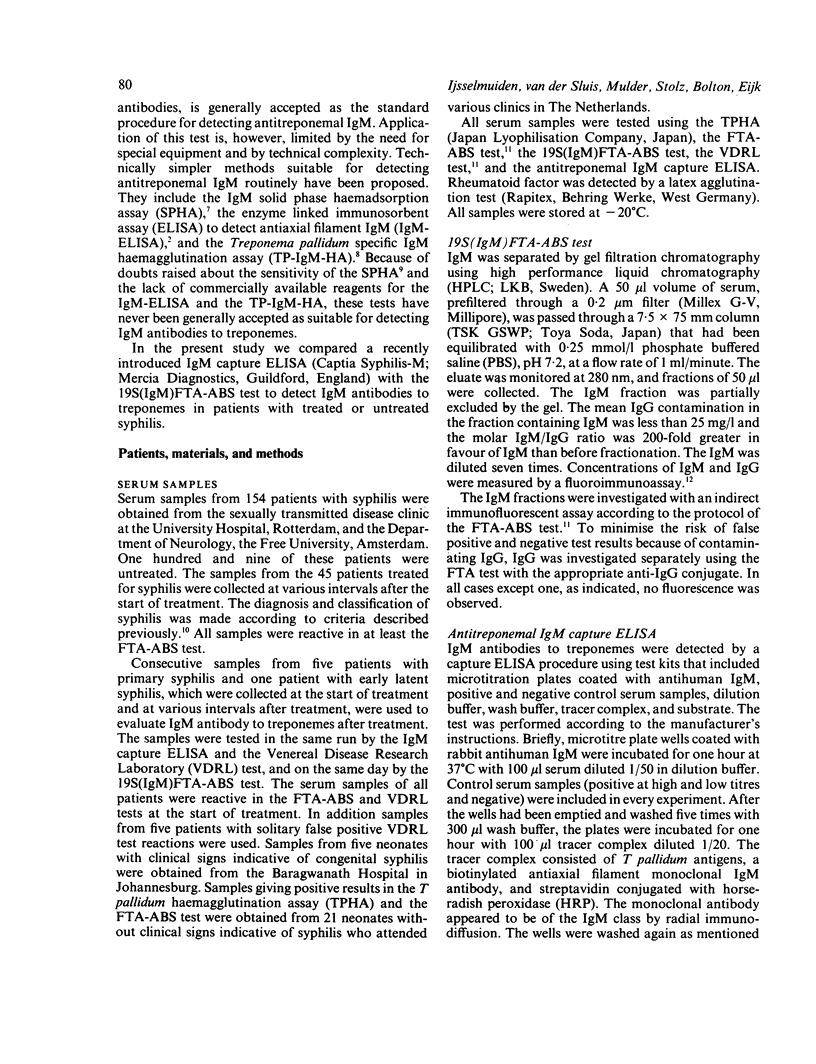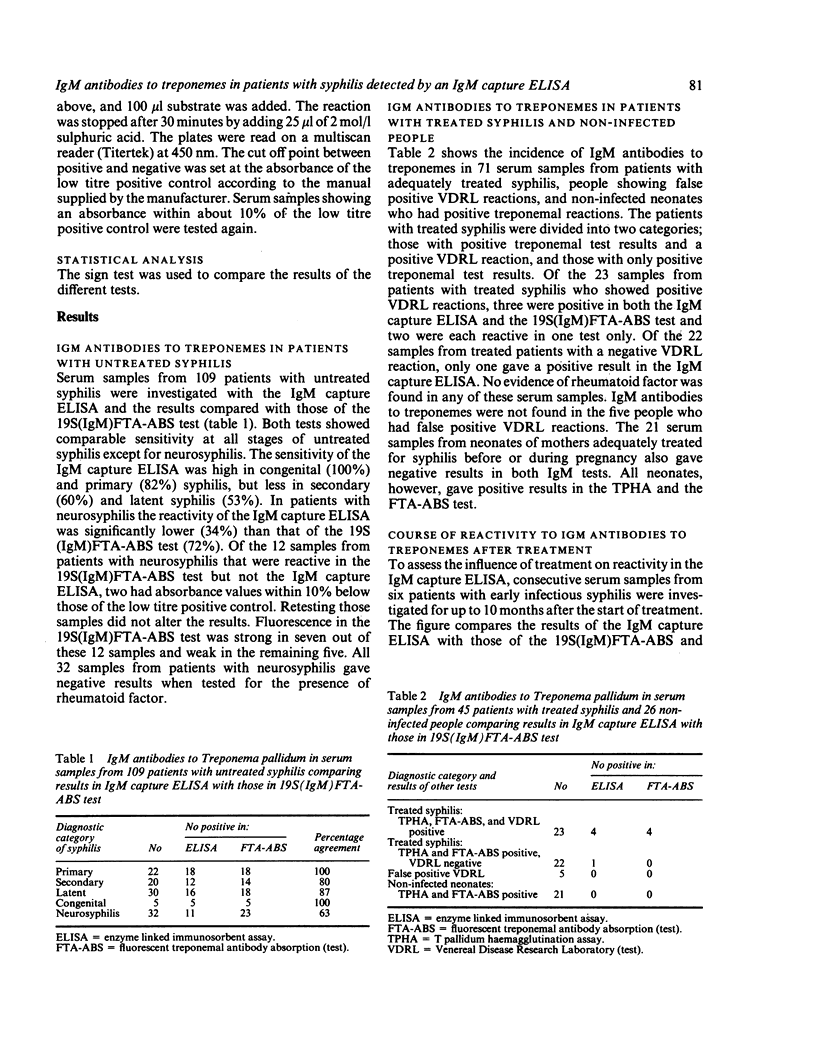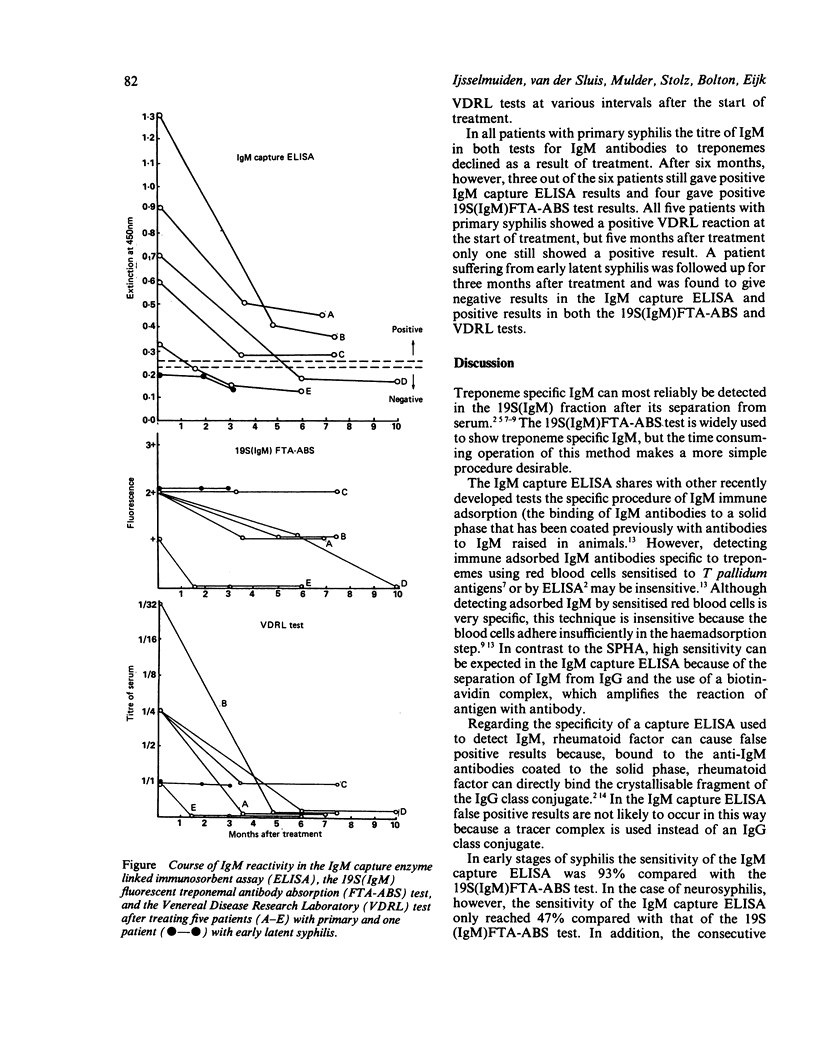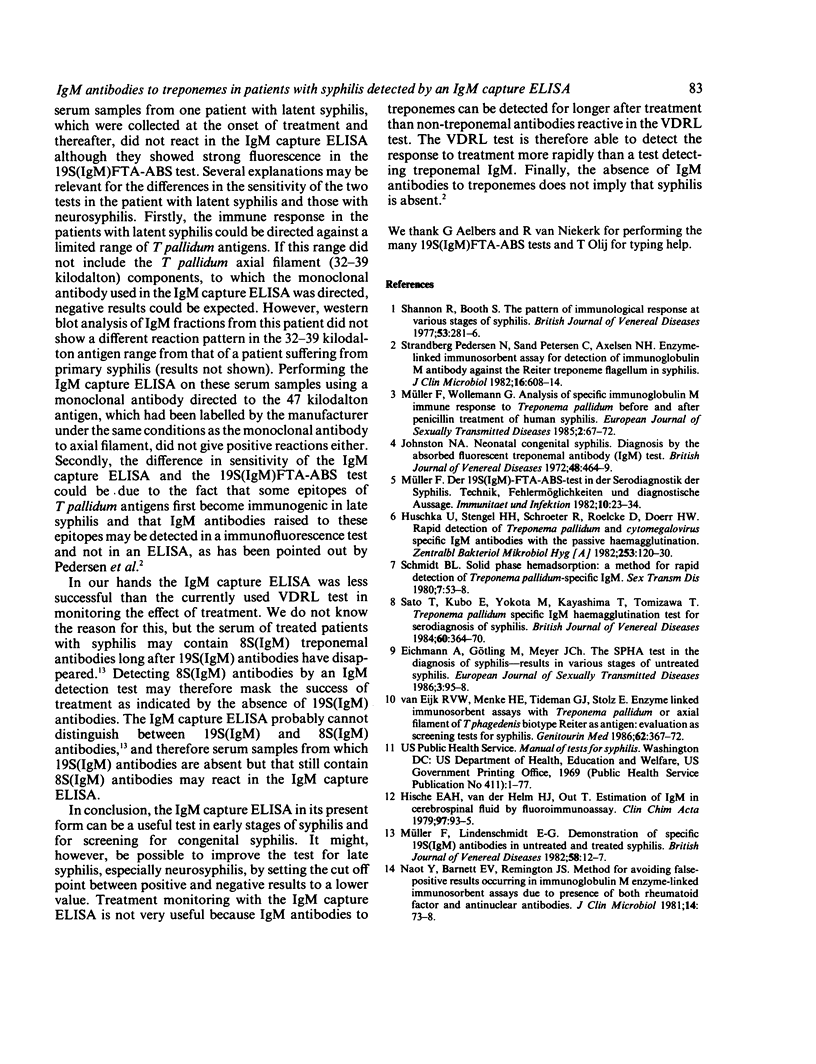Abstract
A new IgM capture enzyme linked immunosorbent assay (ELISA) was compared with the 19S(IgM) fluorescent treponemal antibody absorption (19S(IgM)FTA-ABS) test for detecting IgM antibodies to treponemes. Serum samples from 180 people, 109 with various stages of untreated syphilis, 45 with treated syphilis, and 26 non-infected, were investigated. In all diagnostic groups of syphilis the reactivity of the IgM capture ELISA was similar to that of the 19S(IgM)FTA-ABS test except in untreated neurosyphilis, for which the IgM capture ELISA was significantly less sensitive. The IgM capture ELISA was very sensitive in congenital (100%, 5/5) and primary (82%, 18/22) syphilis, but less sensitive in secondary (60%, 12/20), latent (53%, 16/30), neurosyphilis (34%, 11/32), and treated (11%, 5/45) syphilis. False positive IgM capture ELISA results were not found in five people who gave false positive Venereal Disease Research Laboratory (VDRL) reactions or in 21 neonates born to mothers adequately treated for syphilis before or during pregnancy. This indicated that the IgM capture ELISA was very specific. The course of antitreponemal IgM reactivity after treatment of early infectious syphilis was followed up in six patients. The quantity of IgM antibody declined in nearly all patients after treatment, but still remained detectable in five patients up to six months after treatment. In contrast, non-treponemal antibodies measured by the VDRL test disappeared in four out of six patients within five months from starting treatment. In conclusion, the IgM capture ELISA may be useful for easy and sensitive detection of IgM antibodies to treponemes in patients with congenital and primary syphilis. A positive test result in these cases indicates that patients should receive treatment if they have not been treated recently. The test is not, however, recommended to replace the VDRL test to monitor patients treated for syphilis.
Full text
PDF




Selected References
These references are in PubMed. This may not be the complete list of references from this article.
- Hische E. A., van der Helm H. J., Out T. Estimation of IgM in cerebrospinal fluid by fluoroimmunoassay. Clin Chim Acta. 1979 Sep 15;97(1):93–95. doi: 10.1016/0009-8981(79)90029-9. [DOI] [PubMed] [Google Scholar]
- Huschka U., Stengel H. H., Schroeter R., Roelcke D., Doerr H. W. Rapid detection of Treponema pallidum and cytomegalovirus specific IgM antibodies with the passive haemagglutination. Zentralbl Bakteriol Mikrobiol Hyg A. 1982 Oct;253(1):120–130. [PubMed] [Google Scholar]
- Johnston N. A. Neonatal congenital syphilis. Diagnosis by the absorbed fluorescent treponemal antibody (IgM) test. Br J Vener Dis. 1972 Dec;48(6):464–469. doi: 10.1136/sti.48.6.464. [DOI] [PMC free article] [PubMed] [Google Scholar]
- Müller F. Der 19S(IgM)-FTA-ABS-Test in der Serodiagnostik der Syphilis. Technik, Fehlermöglichkeiten und diagnostische Aussage. Immun Infekt. 1982 Jan;10(1):23–34. [PubMed] [Google Scholar]
- Müller F., Lindenschmidt E. G. Demonstration of specific 19S(IgM) antibodies in untreated and treated syphilis. Comparative studies of the 19S(IgM)-FTA test, the 19S(IgM)-TPHA test, and the solid phase haemadsorption assay. Br J Vener Dis. 1982 Feb;58(1):12–17. doi: 10.1136/sti.58.1.12. [DOI] [PMC free article] [PubMed] [Google Scholar]
- Naot Y., Barnett E. V., Remington J. S. Method for avoiding false-positive results occurring in immunoglobulin M enzyme-linked immunosorbent assays due to presence of both rheumatoid factor and antinuclear antibodies. J Clin Microbiol. 1981 Jul;14(1):73–78. doi: 10.1128/jcm.14.1.73-78.1981. [DOI] [PMC free article] [PubMed] [Google Scholar]
- Pedersen N. S., Petersen C. S., Axelsen N. H. Enzyme-linked immunosorbent assay for detection of immunoglobulin M antibody against the Reiter treponeme flagellum in syphilis. J Clin Microbiol. 1982 Oct;16(4):608–614. doi: 10.1128/jcm.16.4.608-614.1982. [DOI] [PMC free article] [PubMed] [Google Scholar]
- Sato T., Kubo E., Yokota M., Kayashima T., Tomizawa T. Treponema pallidum specific IgM haemagglutination test for serodiagnosis of syphilis. Br J Vener Dis. 1984 Dec;60(6):364–370. doi: 10.1136/sti.60.6.364. [DOI] [PMC free article] [PubMed] [Google Scholar]
- Schmidt B. L. Solid-hase hemadsorption: a method for rapid detection of Treponema pallidum-specific IgM. Sex Transm Dis. 1980 Apr-Jun;7(2):53–58. [PubMed] [Google Scholar]
- Shannon R., Booth S. D. The pattern of immunological responses at various stages of syphilis. Br J Vener Dis. 1977 Oct;53(5):281–286. doi: 10.1136/sti.53.5.281. [DOI] [PMC free article] [PubMed] [Google Scholar]
- van Eijk R. V., Menke H. E., Tideman G. J., Stolz E. Enzyme linked immunosorbent assays with Treponema pallidum or axial filament of T phagedenis biotype Reiter as antigen: evaluation as screening tests for syphilis. Genitourin Med. 1986 Dec;62(6):367–372. doi: 10.1136/sti.62.6.367. [DOI] [PMC free article] [PubMed] [Google Scholar]


